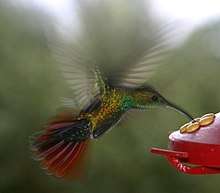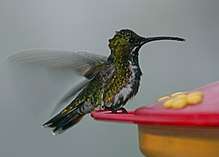Green-breasted mango
The green-breasted mango (Anthracothorax prevostii) is a hummingbird from tropical America. The scientific name of this bird commemorates the French naturalist Florent Prévost.
| Green-breasted mango | |
|---|---|
RWD.jpg) | |
| Scientific classification | |
| Kingdom: | Animalia |
| Phylum: | Chordata |
| Class: | Aves |
| Order: | Apodiformes |
| Family: | Trochilidae |
| Genus: | Anthracothorax |
| Species: | A. prevostii |
| Binomial name | |
| Anthracothorax prevostii (Lesson, 1832) | |
Description
Adults of this medium-sized hummingbird species are 11–12 cm in length. Males average 7.2 g, females, 6.8 g. The longish black bill is slightly decurved. The tail in both sexes has dark central feathers. In adult males, the outer tail feathers are deep magenta to wine purple tipped with black. In females and juvenile males, the outer tail feathers are broadly banded in magenta and iridescent dark blue, with narrow white tips on the outer 3–4 feathers.

The adult male has glossy bright green upperparts. His throat and chest have a relatively narrow matte black central area, bordered with blue-green. The flanks are bright green, and the black of the chest tapers onto the belly.

Females and immature males have bronze-green upperparts and largely white underparts with a dark central stripe that changes from black at the chin to blue-green on the throat. Immature birds of both sexes usually show some gray or buff feather edges on the head and wings and are mottled with cinnamon to rusty brown along the edges of the white breast-belly stripe. Immature females have less extensive magenta in the outer tail feathers than adult females or immature males.
The call of the green-breasted mango is a high-pitched tsup, and the song is a buzzing kazick-kazee-kazick-kazee-kazick-kazee-kazick-kazee.
This species is very similar to the closely related black-throated mango. Although the male green-breasted mango has less extensive black on the underparts, this and other plumage differences are not always easy to confirm in the field because the birds appear all-black. The females of the two species can be almost inseparable, although green-breasted has more extensively coppery upperpart tones than its relative.
Distribution and ecology
This species breeds from eastern and southern Mexico south through Central America, including some near-shore islands, to Costa Rica. In western and central Panama, it is replaced by the possibly conspecific Veraguan mango Anthracothorax veraguensis. Disjunct populations occur along the northern coast of South America from extreme northeastern Colombia through northernmost Venezuela, in the upper Cauca River Valley of southwestern Colombia, and on the coastal slope of southwestern Ecuador and extreme northwestern Peru.
The species is partially migratory, occupying its breeding range in northeastern Mexico (southwestern Tamaulipas and eastern San Luis Potosí to southern Veracruz and extreme western Tabasco) from late February through September. Other movements are poorly understood, but the wide separation of populations in South America suggests a species-wide propensity to travel and/or a more continuous distribution during periods when South America's climate was warmer and drier.
Young birds are responsible for the majority of occurrences in the United States. The first green-breasted mango documented north of Mexico was photographed in coastal Texas in September 1988. The species has since become an increasingly frequent vagrant and extremely rare resident in the lower Rio Grande Valley of southern Texas.
Only three individuals have been documented in the U.S. outside Texas, all visiting feeders at private homes: a juvenile male in Concord, North Carolina in November 2000, a juvenile male in Beloit, Wisconsin first identified in September 2007, and a juvenile bird, possibly a male, in Dublin, Georgia, in October 2007.[2][3][4][5] Neighbors of the Wisconsin bird's hosts report that the bird had been visiting their feeders since late July. On November 5, 2007, the Beloit green-breasted mango was captured to prevent its death from winter weather. Against the advice of hummingbird experts, the bird was transferred from the Wildlife Rehabilitation Center of the Wisconsin Humane Society to the Brookfield Zoo, near Chicago, which elected to confine the bird permanently with five hummingbirds already in its Perching Bird House.
The species inhabits tropical deciduous forest, open landscapes with scattered large trees, orchards, gardens, and cultivated areas, but its distribution is spotty and often localized.
Like all hummingbirds, it feeds on insects and other invertebrates and nectar. Prey is often taken in mid-air but may also be gleaned from vegetation or stolen from spider webs (a behavior known as kleptoparasitism). Favorite nectar sources include the flowers of large trees such as Inga, Erythrina, and Ceiba or kapok.
The female green-breasted mango lays two white eggs in a tiny cup nest on a high, thin, and usually bare, branch. The exterior of the nest is camouflaged with chips of lichen and other plant fragments. Incubation by the female is 16 to 17 days, and the nestling period lasts another 24.
At a green-breasted mango nest on San Andrés Island (Caribbean), it was noted that the tree was beset with Pseudomyrmex stinging ants. This was also noted at a black-throated mango nest in Cuyabeno Faunistic Reserve, Ecuador. It is likely that the ants would deter predators, but it is not known whether the birds deliberately select such trees for nesting.[6]
Conservation status
The green-breasted mango has been evaluated by the World Conservation Union, a.k.a. International Union for the Conservation of Nature and Natural Resources (IUCN) and categorized as a species of Least Concern.
The species is not currently protected in the U.S. under the Migratory Bird Treaty Act. Proposed revisions to the act, published in the Federal Register on August 24, 2006,[7] would extend protection to this and 85 other species of accidental or casual occurrence in the United States, Puerto Rico, or the U.S. Virgin Islands. The revisions had not been approved as of November 2007, which allowed the capture and permanent captivity of the Wisconsin green-breasted mango to proceed without federal approval.
References
- BirdLife International (2012). "Anthracothorax prevostii". IUCN Red List of Threatened Species. 2012. Retrieved November 26, 2013.CS1 maint: ref=harv (link)
- Green-breasted Mango: October 29, 2007. Narba.org. Retrieved on November 20, 2011.
- Rare bird – Beloit Daily News: News. Beloit Daily News (September 22, 2007). Retrieved on November 20, 2011.
- Watchers abuzz about rare bird – Rockford, IL – Rockford Register Star Archived February 1, 2013, at Archive.today. Rrstar.com. Retrieved on November 20, 2011.
- Nikolai, Geri. (2007-09-28) Rare hummingbird sightings heading south – Rockford, IL – Rockford Register Star. Rrstar.com. Retrieved on November 20, 2011.
- Greeney & Merino M. (2006)
- General Provisions; Revised List of Migratory Birds| Federal Register Environmental Documents | USEPA. Epa.gov. Retrieved on November 20, 2011.
- del Hoyo, Josep et al. eds. (1999): Handbook of the Birds of the World Volume 5: Barn-owls to Hummingbirds. Lynx Edicions, Barcelona. ISBN 84-87334-25-3
- Greeney, Harold F. & Merino M., Paúl A. (2006): Notes on breeding birds from the Cuyabeno Faunistic Reserve in northeastern Ecuador. Boletín de la Sociedad Antioqueña de Ornitología 16(2): 46–57. PDF fulltext
- Hilty, Steven L. (2003): Birds of Venezuela. Christopher Helm, London. ISBN 0-7136-6418-5
- Ridgely, Robert S. (1976): A Guide to the Birds of Panama. Princeton University Press, Princeton, New Jersey. ISBN 0-691-08174-3
- Williamson, Sheri L. (2001): A Field Guide to Hummingbirds of North America. Peterson Field Guide Series, Houghton Mifflin Co., Boston. ISBN 0-618-02496-4
External links
- Green-breasted Mango videos on the Internet Bird Collection
- Green-breasted Mango; RangeMaps & Article InfoNatura NatureServe
